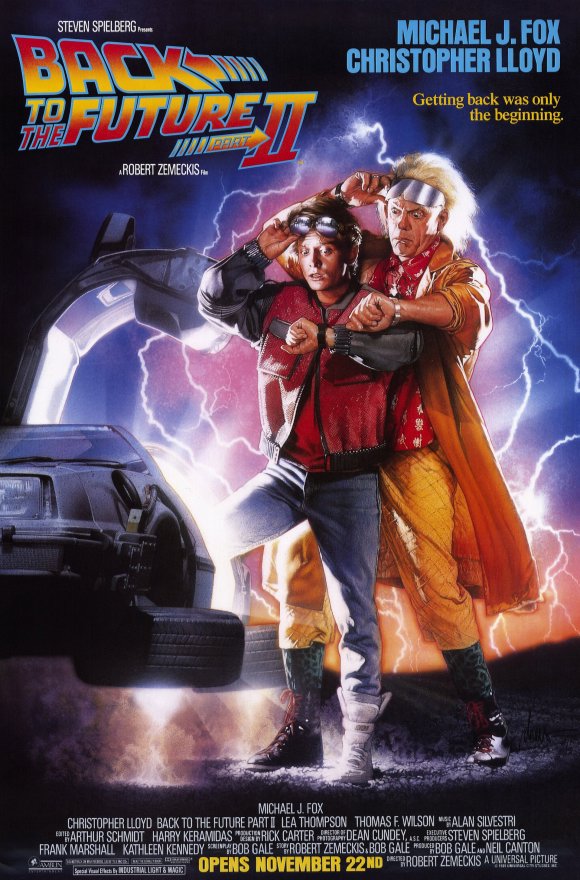Back to the Future: Part 2 (1989): A Temporal Odyssey in Cinematic Brilliance – Review

Sailing again through the tumultuous seas of time, “Back to the Future Part II” captivates and continues the cinematic voyage that started with its legendary predecessor. Orchestrated by the imaginative maestro, Robert Zemeckis, this sequel amplifies the original’s inventive spirit, weaving new threads into the tapestry of temporal storytelling. With a fervor for futuristic creativity, intertwined with the charm of revisiting and reshaping historical moments, the film unfolds as a labyrinth of delightful paradoxes and predictive marvels.
The Fabric of Time: Weaving the Narrative
Embedded within the movie is a narrative fabric, meticulously woven with strands of continuity, speculation, and transformative possibilities. The return of Marty McFly (Michael J. Fox) and Dr. Emmett Brown (Christopher Lloyd) catapults the audience into futures of flying cars and self-lacing shoes, realms both whimsical and reflective of societal progression. A spectrum of timelines unfolds, each meticulously crafted to echo with familiarity while resonating with the novel sceneries and situations, elucidating the ripple effects of each temporal intervention.
Mastery in Direction and Performance
Robert Zemeckis’ direction triumphs as the movie’s navigational compass, guiding audiences through intricate temporal terrains with a fluidity that harmonizes complexity with clarity and captivation. Michael J. Fox and Christopher Lloyd return to their iconic roles, each character enveloped in multitudes of emotional and chronological nuances.
The ensemble cast, including Lea Thompson and Thomas F. Wilson, contribute dimensions that resonate with a spectrum of humor, emotion, and temporal diversity, their performances adapting gracefully to the variances of each era’s distinct but interconnected universe.
Technological Triumphs: Production Innovations
Venturing behind the cinematic curtain unveils a galaxy of technological triumphs and production marvels. A groundbreaking utilization of VistaGlide motion control technology allowed seamless interaction in scenes involving the same actor in multiple roles, a dazzling choreography of technical precision and performance artistry.
The portrayal of 2015 is a cinematic canvas painted with imaginative technologies, speculative societal shifts, and detailed design choices that curated a future both fantastical and resonating with subtle reflections of potential reality.
Artistic Alchemy: Design and Musical Compositions
Design elements within the film emerge as pivotal architects of temporal atmosphere, each era delineated with meticulous attention to environmental composition, costume, and prop details, enhancing the visceral journey through each epoch’s unique ambiance.
Alan Silvestri’s musical compositions echo with temporal versatility, resonating with melodies that traverse and adapt to the unfolding sagas of past, present, and speculative futures, enriching the auditory exploration of the film’s diverse chronological realms.
Disappearing Act: Crispin Glover’s Absence
Crispin Glover’s portrayal of George McFly in the first “Back to the Future” movie resonated with a distinctive brilliance, weaving threads of vulnerability, quirkiness, and transformation into the narrative tapestry. However, as the curtains rose on the sequel, Glover’s presence vanished from the cinematic stage, resulting in a creative divergence that echoed with implications and industry reflections.
The roots of Glover’s absence can be traced to a confluence of disputes and disagreements, primarily revolving around contractual and creative realms. Economic considerations, creative differences, and diverging visions regarding the character’s trajectory and the film’s thematic expressions contributed to a parting of pathways between Glover and the film’s creative consortium.
In the wake of his absence, Glover initiated legal actions, grounded in contentions regarding the utilization of his likeness and the portrayal of George McFly in the sequel. This legal voyage resulted in a settlement, but its echoes reverberated far beyond, prompting a reevaluation and restructuring of industry norms and regulations concerning actors’ rights and the utilization of performers’ likenesses.
Glover’s legal pursuits and their resulting impacts unfolded as a significant chapter in the evolution of performers’ rights and industry operational frameworks within Hollywood. It became a pivotal moment, inspiring a reexamination and refinement of the legal and ethical dimensions of creative representations and contractual engagements within the cinematic arenas.
Tapestry of Influences: Cultural and Cinematic
“Back to the Future Part II” weaves its influence into the tapestry of cinematic evolution and cultural imaginings. Its predictive portrayals, humorous insights, and imaginative explorations ripple through the realms of creative inspiration, technological aspirations, and collective cultural reflections.
In its wake, the film leaves a legacy of influence, a beacon illuminating pathways for storytelling artistry, technological exploration, and the imaginative odyssey of cinema. Its contributions reverberate as inspirations and benchmarks within the evolving dialogues and landscapes of cinematic creativity.
Venturing through “Back to the Future Part II” is a voyage through vibrant galaxies of creativity, technological wonder, and imaginative exploration. The film sails through the temporal oceans with a fearless spirit of innovation, leaving behind a legacy of timeless allure, enchanting mysteries, and the unforgettable magic of cinematic storytelling. Its journeys through the realms of possibility and the corridors of time sparkle with the lights of inspiration, adventure, and the boundless potentials of cinematic artistry.




